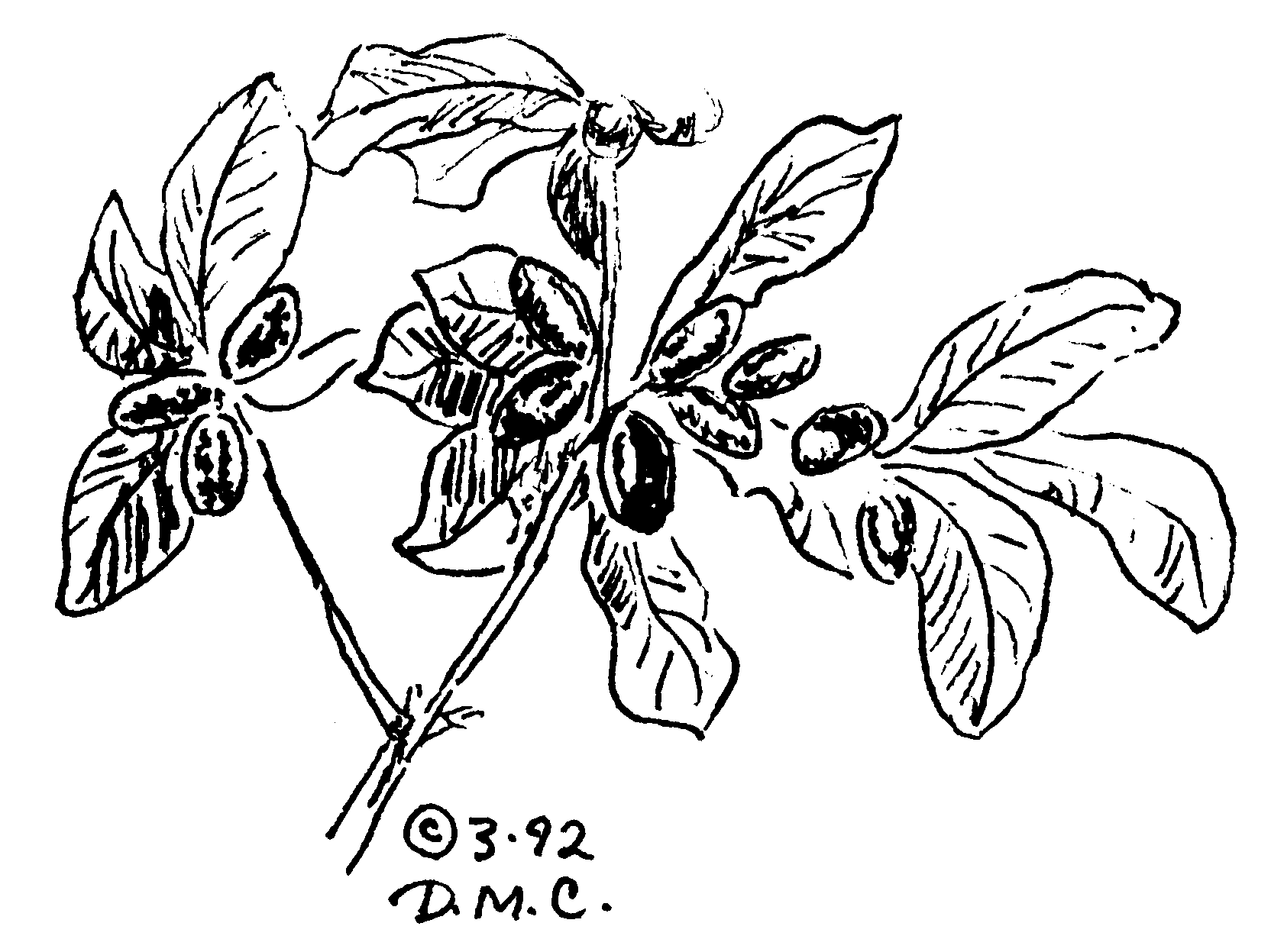

| Let's hear from
an habitual perpetrator, in his own words... "when showing visitors
around the property they say, what are those little red oval
berries? Are they edible?' So we give them a taste and admit they are
pretty insignificant. Then when we get to a lime tree we announce. This
is a special Jambolana Lime—very sweet!' Disbelief is in their eyes,
because they've got lime trees in their gardens, and they can't see any
difference—and there isn't! So we
snip off a fat green lime, cut it in half and say. Try it.' There's a
tentative
lick, then an incredulous smile, then more licks. Everyone wants to
taste
it. 'Wonderful, where did you get it? Did you grow it from seed? Or was
it grafted? Will you let us have some scions? Will you make a marcotte
for
us?' Etc., and so the hoax goes on." And so Jack Rolley of Jambolana
Farm
in Tahiti boasts of his habitual duplicity. Even a founder of the Rare Fruit Council, William Whitman, admits to falling for the sweet lime trick. In 1952, he was being given a tour of the Panama Canal Zone Summit Gardens by the Director, W. R. Lindsay, when they encountered a five foot bush, covered with small, dark green leaves and attractive red fruit about the size of olives. Sampling a couple of the berries, Mr. Whitman found them rather nondescript, and they moved to the next specimen, a Key lime which Director Lindsay asserted was a wonderful and very rare sweet lime. After some urging to sample it, Mr. Whitman tasted this lime and found it absolutely living up to its advance billing—incredibly sweet and delicious. Only after eating several more of these delightful sweet limes did he finally ask for information. Has this happened to you, or someone you know? I certainly hope so—because that kind of magical, although admittedly duplicitous, experience is one not easily forgotten. And it should make you into an enthusiastic devotee—although NOT of the "sweet lime", which still, at this writing, dwells amongst unicorns and other mythical beasts—but of the small red berries that are the real heroes of this tale. |
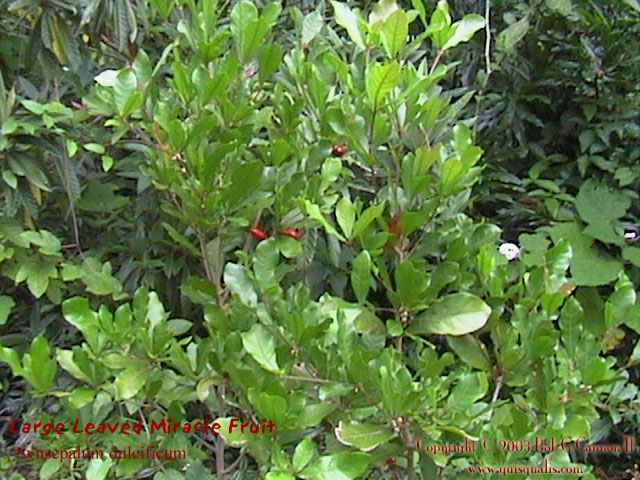
|
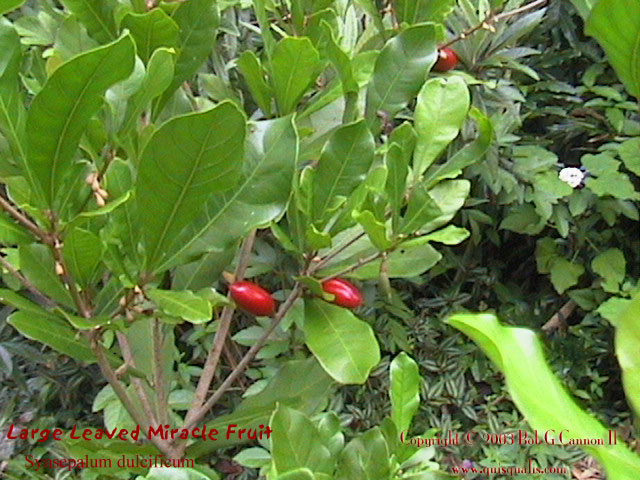
|
Members of the Rare
Fruit Council should be much more familiar than the general public with
these red berries, which are most commonly called the Miracle Fruit;
and seldom was a common name more correct! No one knows for sure when
the first person made the discovery about the taste reversing
properties... but
it was probably many centuries ago. The plant was discovered in West
Africa,
where the native diet revolved around a few basic foods, none of which
were remotely sweet. Their soups and porridges were sour, their crude
cornbread
sour, their fermented palm beer and wine extremely sour. Sweeteners
were
at a premium. Can you imagine the delight of these people when someone
ate
a few red berries and later ate a meal of these foods, to find
everything suddenly sweet and very palatable? One hopes that the
connection was made right away! This practice was first reported in 1725 by the French explorer Des Marchais, although he made no recorded attempt to name the fruit or describe it fully. This West African wonder was not botanically identified and named until the middle of the 19th century as Synsepalum dulcificum, a member of the Sapotaceae family, relative of the sapodilla (Manilkara zapota). In the Pharmaceutical Journal, Vol. Xl, published in 1852, Dr. W. F. Daniell called it the "miraculous berry". He was stationed at an outpost in West Africa, and described the taste-reverse properties in great detail. Contemporary botanists were very naturally excited by his writings and possibilities for commercial exploitation were eagerly discussed. A great deal of time, thought, planning, dreaming, and money have been spent on that very idea during the last century and a half. Yet the general public is still unaware of this rare fruit and the effect it could have on enhancing the quality of their lifestyle. |
| One of the first
problems encountered was that the berries are perishable, and once
picked,
last but a few days. In their native habitat, two large crops are
available
yearly, each after a rainy season. The mature bushes, which can reach
20
feet, usually have a few fruits hanging around all year. Methods of
shipment in the last century were not conducive to marketing the fruits
and cultivation of the plants in other countries was also unsuccessful.
However, a few very
rare plants made it around the globe—such as to Summit Gardens, Plant
Introduction
Station in Panama, where one hundred years later, their encounter with
one very dedicated fruit enthusiast has made all the difference for
their
future in the diets of people everywhere. Space does not permit many details in the most extensive—and most expensive—endeavour to introduce and market the miracle fruit. Please refer to the magazine, "Horticulture", January 1985, where author Nathaniel Tripp more fully delves into this mid 1970's entrepreneurial disaster, involving dedicated dreamers, horticultural expertise, brilliant marketing ideas, millions of dollars (private, corporate, and governmental), thorough research, countless hours in laboratories, greenhouses, fields and offices, industrial espionage, propaganda and frightener techniques, thousands of miles of air travel, foot-weary jungle exploration, shrewd native peoples... in short, everything needed for a Hollywood block buster! In a nutshell, although the miracle fruit had been proven to be absolutely and totally safe in the most thorough testing done on every thing from guinea pigs to school children, the company set up to market the fruit and its taste reversing property, Miraculin, was denied crucial FDA approval. This was quite ironically, on the eve of its major introduction into the marketplace, and after ongoing communication with the Food and Drug Administration that had always seemed positive and optimistic. |
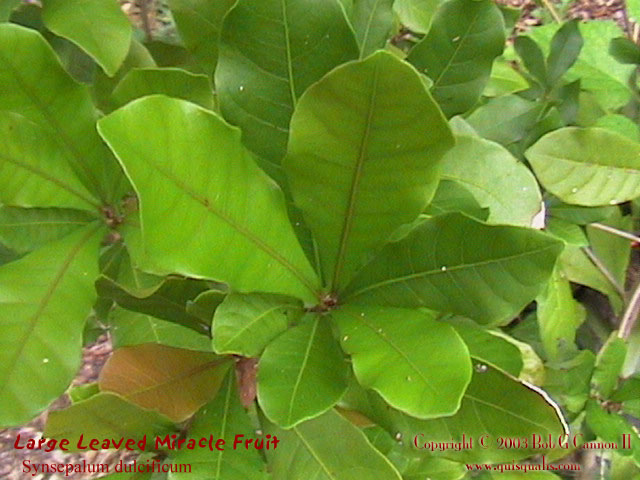
|
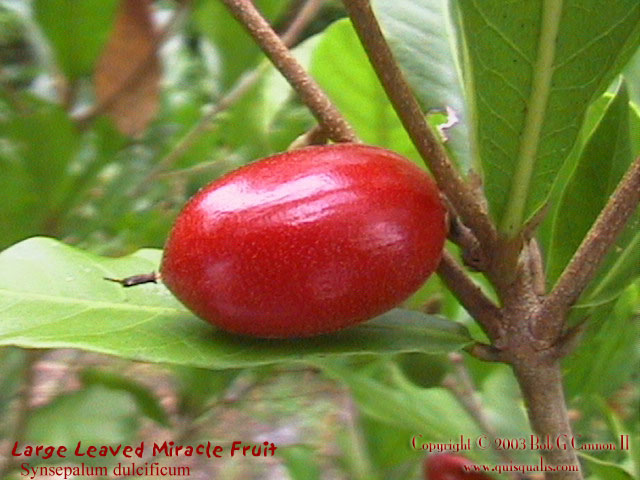
|
Consumers are rarely
cognizant of the life-and-death struggle going on in the food industry;
and nowhere is the battle more bloody than when it comes to sweetening
our food. Cane sugar alone is a multi-billion-dollar, international
industry.
And when it comes to artificial sweeteners... we are talking major war!
The lovely and graceful branches of Synsepalum dulcificum are hardly
material
to fashion weapons of battle. But for a while there, diabetics,
dentists,
the overweight, children and all of us who crave our sweets with no
retribution
were very close to a major improvement in lifestyle. There are no artificial sweeteners proven absolutely safe. (Although THEY are FDA-approved.) They are used with fingers crossed. Sugar and other "natural" sweeteners are hardly to be considered as food with no ill effects. Hundreds of pounds per person are consumed yearly in more foods that we can suspect or easily detect. A teaspoonful in every tablespoonful of ketchup, for example! Anyone with knowledge of diabetes will comprehend the power of sugar in the diet, with the dangers of this disease to include blindness, stroke, dizziness, blackouts, coma, painful neuropathy, kidney failure, amputation and death. Ask a diabetic about the difficulty of balancing—or detecting— sugar in his diet; an imbalance can prove to have disastrous results. Ask any little kid in the dentist's chair about the sugar that caused his cavities. Ask any one of us "civilized" folks who could stand to lose a few pounds about the difficulty of resisting the onslaught of advertising designed to make us eat sugar in some form or the other. Studies have shown human beings crave and need sugar from earliest infancy. We need it for growth and energy. But only up to a point—most of us, being human, overindulge; and thereby pay the price. |
| Life is too short,
and too full of woe, to deny ourselves ice cream. (NOTE: To fully
appreciate ice cream, of course, never eat it while depressed and
standing in front of the open freezer. Try to make it to the beach to
eat with a loved one while watching the sun rise or set. This is the
only proper way to eat the very best foods.) There is no perfect
solution to every problem; but surely the miracle fruit grows upon this
planet for a reason: to help us live a sweeter life without suffering
dire consequences. A Miraculous Modification The oft asked question, is naturally: What causes the miracle? Just as the desire to take commercial advantage of this berry has caused numerous hopeful experiments/ science has also endeavored to learn the secret. It took many years/ much research and accumulated knowledge and thorough scientific procedures to finally isolate the principle. In the early 1960's/ the makers of the seasoning powder Ac'cent the International Minerals and Chemical Corporation/ (doesn't that sound tasty?) spent a year of concentrated effort trying to isolate the active ingredient but were basically unsuccessful. It was felt that larger quantities of the fresh fruit would have expedited their work. In 1964 their researchers stated/ "the quality of the miracle fruit-induced sweetness is unexcelled... (and) more desirable than any of the known natural or synthetic sweeteners". |
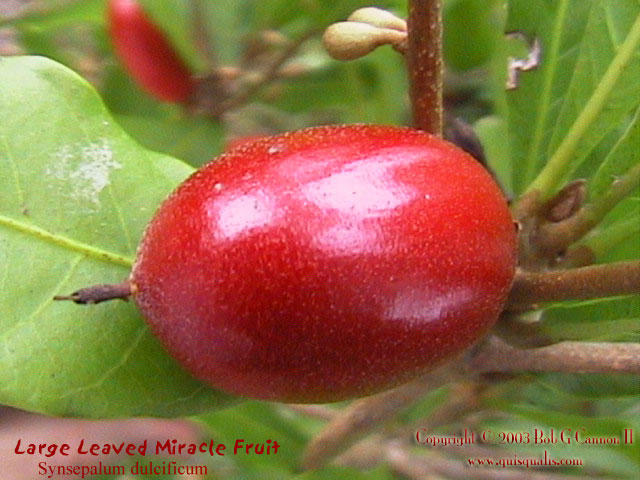
|
| Cover |
Contents |
Next Page |
Next Article |